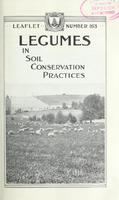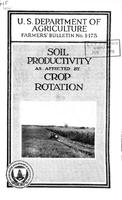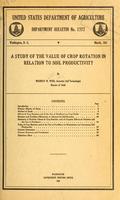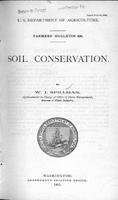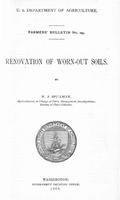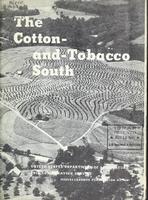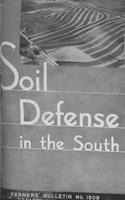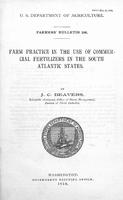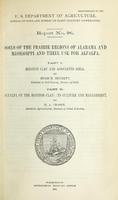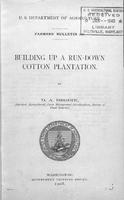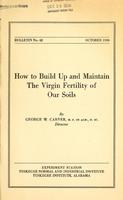Browse Items: 17
Page 1 of 1
Farm Practices That Increase Crop Yields in Kentucky and Tennessee
IN THE LIMESTONE and mountain districts south of the Ohio River there is much land that has been run down by continual cropping without rotation. In some places run-down land is left to grow up in weeds, wild grasses, and brush, a practice known as "resting" the land.
Where this sort of farm management is followed farm manure is largely wasted,…
Where this sort of farm management is followed farm manure is largely wasted,…
Legumes in Soil Conservation Practices
Maintenance of soil productivity is to a large extent bound up with the maintenance of organic matter, which serves to decrease the danger from erosion. Legumes take a prominent place in maintaining soil productivity. Winter legumes are most commonly depended on in the South; red clover and sweetclover in the North. Turning these crops under,…
Soil Productivity as Affected by Crop Rotation
A STUDY of the long-continued soil-fertility experiments of this country and of England, made by the Department of Agriculture. 1 has brought out the following important facts about crop rotation in its relation to soil productivity, as determined by the soil conditions under which these experiments are conducted:
(1) In general, crop rotation…
(1) In general, crop rotation…
A Study of the Value of Crop Rotation in Relation to Soil Productivity
Two methods have been employed in evaluating the effectiveness of rotation in crop production, and in determining the additive effects of rotation and the use of fertilizers when these two farm practices are conjoined. Although in one method the evaluations are based on the increases over the yields obtained on check plots in continuous culture and…
Soil Conservation
How to restore and maintain the productivity of the soil is the most important phase of the conservation problem. We are no longer a new nation. We have deluded ourselves with the idea that we have unbounded resources in land, in forests, in mineral wealth. We have been prodigal in the utilization of these, resources. We must now pay the penalty of…
A Study of Crop Yields and Soil Composition in Relation to Soil Productivity
A careful study of the data which have been presented appears to justify two conclusions.
First. That the productivity of the newer agricultural soils of the United States and of the older agricultural soils of Europe, taken as a whole and for a nation, are not declining, as is popularly supposed. Individual farms deteriorate and soils wear out…
First. That the productivity of the newer agricultural soils of the United States and of the older agricultural soils of Europe, taken as a whole and for a nation, are not declining, as is popularly supposed. Individual farms deteriorate and soils wear out…
Renovation of Worn-Out Soils
We may sum up the matter briefly thus: To build up and maintain fertility in the soil, feed a large part of the crops and return the manure to the land. If manure is not available, plow under crops grown for the purpose. Plow deep (but do not subsoil). Grow leguminous crops for the nitrogen they add to the soil.
Commercial fertilizers and lime…
Commercial fertilizers and lime…
New Landmarks of Soil Conservation
The wealth of this Nation is rooted in the soil. Thirty million people earn their living directly from farms and ranches. The remaining 100 million Americans depend upon the soil for most of their food, much of their clothing, and many other necessities.
Today the soil of this Nation is being wasted away. Erosion is steadily washing good soil…
Today the soil of this Nation is being wasted away. Erosion is steadily washing good soil…
The Cotton-and-Tobacco South
Some of the Nation's richest land, and some of its poorest, lies in the 13 cotton - and - tobacco States: 28 percent of the country's area, a region rich in natural resources, advantages of climate, population, and potentialities.
Industry is growing in the South, but the region still is predominantly agricultural. In addition to cotton,…
Industry is growing in the South, but the region still is predominantly agricultural. In addition to cotton,…
Soil Defense in the South
This bulletin describes farming practices that conserve soil and how such practices may he applied to farms in a large part of the South. Its scope is limited to that part of the Cotton Belt extending west from the Georgia Alabama line to central Texas and southern Oklahoma. Its subject matter is based largely on the soil conservation practices…
Farm Practice in the Use of Commercial Fertilizers in the South Atlantic States
SUMMARY
(1) Commercial fertilizers are expensive. Accurate information is needed for their economic use.
(2) With a good rotation, deep and thorough tillage, and the use of green manures, legumes, and winter cover crops, the quantity of commercial fertilizers required for a given crop yield can be considerably reduced.
(3) The character of…
(1) Commercial fertilizers are expensive. Accurate information is needed for their economic use.
(2) With a good rotation, deep and thorough tillage, and the use of green manures, legumes, and winter cover crops, the quantity of commercial fertilizers required for a given crop yield can be considerably reduced.
(3) The character of…
Soils of the Prairie Regions of Alabama and Mississippi and Their Use for Alfalfa
Throughout the prairie belts of central Alabama and northwestern and central Mississippi occur extensive areas of a dark-colored upland calcareous clay soil which, in addition to being admirably suited to the production of cotton, corn, and grass, is highly adapted to alfalfa.
This upland type of "black prairie land" has been classified by the…
This upland type of "black prairie land" has been classified by the…
Building Up a Run-Down Cotton Plantation
This bulletin is an account of the progress made in three years in changing a run-down cotton plantation into a profitable stock and hay farm. The results obtained from the use of cowpeas and other leguminous crops in restoring the fertility of the land have exceeded the expectations of those in charge of the work. Not only have the crops yielded…
How to Build Up and Maintain the Virgin Fertility of Our Soils
Origin of Scientific Agriculture
One is not only surprised but astonished to learn that less than a century and a half ago, agriculture was without a scientific working basis. Credit goes to the great German chemist, Justus von Liebig for starting this revolutionary movement. The following four laws which form the foundation of modern…
One is not only surprised but astonished to learn that less than a century and a half ago, agriculture was without a scientific working basis. Credit goes to the great German chemist, Justus von Liebig for starting this revolutionary movement. The following four laws which form the foundation of modern…
Study of the Soils of Macon County, Alabama, and Their Adaptability to Certain Crops
LOCATION AND BOUNDARIES
Macon County, “the garden-spot of Alabama,” lies near the eastern boundary of the State, about 135 miles north of the Florida-Alabama line. It has an area of 621 square miles, embodying 397,440 acres. It is 34 miles in extent from east to west, and 24 3/4 miles from north to south. The northern and western boundary lines…
Macon County, “the garden-spot of Alabama,” lies near the eastern boundary of the State, about 135 miles north of the Florida-Alabama line. It has an area of 621 square miles, embodying 397,440 acres. It is 34 miles in extent from east to west, and 24 3/4 miles from north to south. The northern and western boundary lines…
How to Build Up Worn Out Soils
The subject of soil improvement through natural agencies has been one of much concern to both ancient and modern agriculturists.
The ancient Egyptian knew that if he let his land lie idle, (rested) as he termed it, he was able to produce a much better crop, and that crop would be in quantity and quality, all other things being equal,…
The ancient Egyptian knew that if he let his land lie idle, (rested) as he termed it, he was able to produce a much better crop, and that crop would be in quantity and quality, all other things being equal,…
Fertilizer Experiments on Cotton
The cotton fertilizer experiments made in 1898 are a continuation of a series of fertilizer soil tests commenced in 1897. The soil of the experimental field, a part of the station farm, is a light and sandy upland, with yellow clay subsoil.
The soil selected is excellently adapted for experimental purposes, having formed part of an old field…
The soil selected is excellently adapted for experimental purposes, having formed part of an old field…
Page 1 of 1
 An official website of the United States government.
An official website of the United States government.



